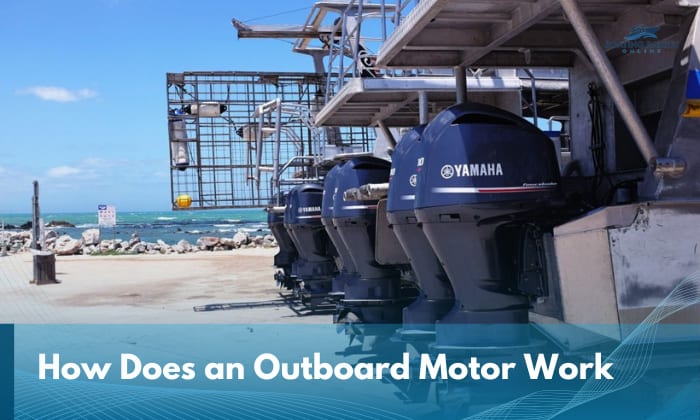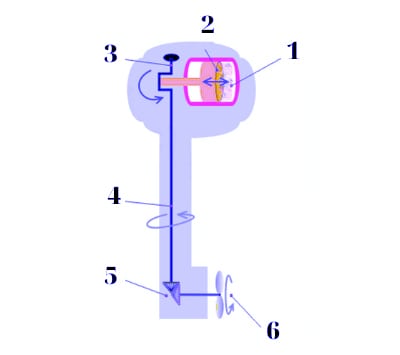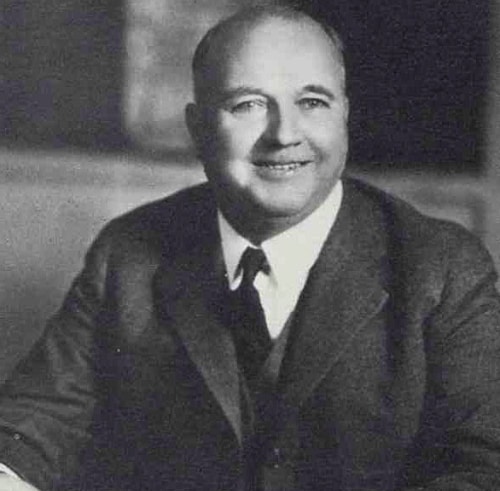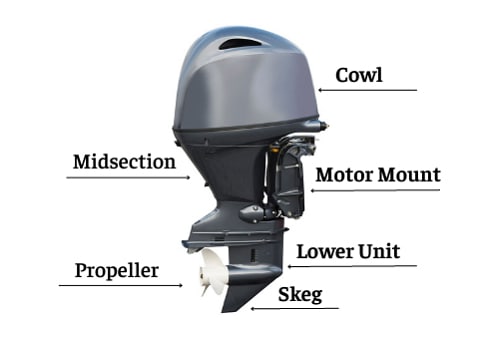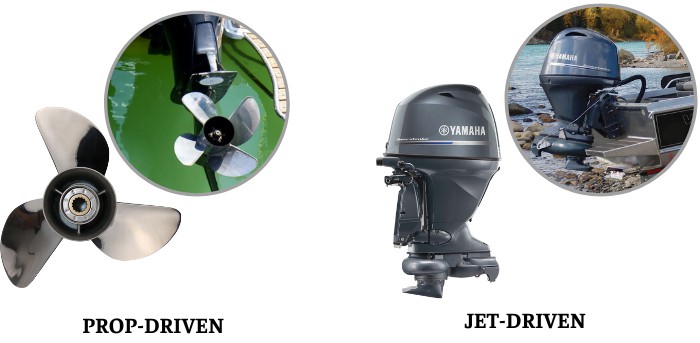Was “How does an outboard motor work?” one of the first questions that floated into your mind when you laid eyes on it? Let’s satisfy that curiosity, then.
An outboard boat engine works by powering a propeller that moves the vessel. How it manages to do that involves the creation of power and motion that specific components transmit and convert from the cylinder to the prop.
That’s as simple as it can get, though. For a more thorough explanation, read on.
Table of Contents
- What Is an Outboard Motor?
- Who Invented the Outboard Motor?
- The Components of an Outboard Motor
- The Working Mechanism of an Outboard Motor
- 2-stroke Vs 4-stroke Outboard Motor: What’s the Difference?
- Types of Outboard Motors
- Maintenance of an Outboard Motor
- Troubleshooting an Outboard Motor
- Frequently Asked Questions
- Conclusion
What Is an Outboard Motor?
Essentially, it’s a motor that powers a propeller that’s responsible for moving a boat. Think of how car engines are designed. Take out a few cylinders and replace the gearbox with a prop, and voila, it becomes an outboard.
Nowadays, outboard motors come in plenty of shapes and forms, but what’s certain is that they’re almost always mounted on the transom. The classic look of this type of boat motor immediately stands out with its long cylindrical body that bears a “head” which houses the engine.
One of the modern offerings by Honda Marine still has this look, as depicted in the picture below.
More powerful and innovative motors sometimes sport a bulkier, aptly heavy-duty appearance, thereby challenging the norm.
Who Invented the Outboard Motor?
Of course, we wouldn’t be enjoying this much variety in our boats if someone didn’t lay the groundwork. Its invention is credited to Norwegian-born, Ole Evinrude.
It’s quite an interesting story. His motivation was sown in 1906 when he failed to fetch ice cream from across a lake for his future wife. Just three years after that incident, the Evinrude outboard prototype was released, and the rest is history.
Outboard motor basics may have already undergone a number of improvements over time, but his principles are still apparent in modern times. You only need to look at how we mount and operate an outboard motor today to see that his legacy still lives on.
The Components of an Outboard Motor
On the whole, we need to divest an outboard motor and look at its intricate engineering to intimately know how it works. This starts by singling out every component.
- Propeller – responsible for moving the boat through the water.
- Starter motor – can either be electrically or manually triggered to start the motor.
- Gearbox – contains the clutch and gears responsible for moving the prop.
- Pistons – move back and forth to transfer energy to the crankshaft.
- Fuel pump – transfers fuel the carburetors need to function.
- Carburetors – combine air with fuel to form explosive mixtures used in each cylinder.
- Crankshaft – collects power from the pistons to maintain speed.
- Flywheel – accumulates momentum to maintain speed.
- Camshaft – allows fuel in and also functions as an exhaust.
- Cylinders – house the pistons and fuel tank that produce power. They come with spark plugs that ignite fuel.
- Anti-ventilation and anti-cavitation plate – prevents these two issues that may damage the prop over time.
- Mounting bracket – where the motor is installed. It’s designed to allow the motor to swivel up or down.
- Cooling system – draws water to maintain optimal temperatures for the prop’s engine.
The Working Mechanism of an Outboard Motor
In Theory
The working mechanism of a standard outboard motor engine begins in a cylinder where fuel is burned to create power. As the gases expand, they move the piston back and forth. The motion transfers to a crankshaft, which converts it to a spinning motion.
The motion turns the driveshaft that runs down the motor’s spine. In turn, the gearbox converts that movement into a horizontal rotary one that, finally, powers the prop.
This diagram provides a basic overview:
In Practice
If you want to know how the components function and the step-by-step mechanism involved, I’ve outlined it here. I based it mainly on how Suzuki described their invention back in 1997 through a patent. Overall, it’s close to the modern outboard motors present in the market today.
- The fuel pump draws fuel from the tank and then sends it to the integrated engine.
- The engine then draws air through the intake. Once it does, the carburetor kicks in, precisely mixing the right proportion of air and fuel.
- The mixture is sent to the engine, which the sparking plug will proceed to ignite in a dedicated combustion chamber.
- As burning fuel expands, it will start pushing the piston down. That, in turn, is connected to the crankshaft, which converts the linear motion to a spinning one.
- The transmission system will “catch” this rotating motion and then transmit it to the propeller.
- That rotational motion will be converted by the prop into thrust, which propels the boat forward.
As you can see, there are not that many deviations from the theory mechanism. Granted, I only focused on the components responsible for propelling the boat, but that’s arguably the most important thing for most boaters.
The rest of the basic parts are primarily responsible for either maintaining speed or keeping the prop working smoothly.
2-stroke Vs 4-stroke Outboard Motor: What’s the Difference?
Do you ever wonder why some people choose a 4-stroke outboard engine in a heartbeat over its 2-stroke counterpart? Did you know that both can influence and change an outboard motor’s design?
I can sum up the differences between the two as follows:
- A 2-stroke engine requires two movements (strokes of the piston) to complete a cycle, but a 4-stroke needs four to perform the same thing.
- This makes 4-stroke engines more complex, larger, and heavier than their 2-stroke counterparts since they require more components like a separate oil system and valve train.
- People prefer 4-stroke outboard motors because they have better fuel economy, are environmentally friendly, and are far less noisy.
Types of Outboard Motors
Outboards can be categorized based on their fuel (whether they run on diesel, propane, gas, or electricity), size (usually means portability vs bulkiness and performance), and shaft length. All of these are fairly self-explanatory.
The most important classification, to me, is based on propulsion. They can be classed as either propeller- or jet-driven.
- Prop-driven – the classic outboard that offers ease of use and arguably the best efficiency. The bigger the prop of the outboard, the more thrust it produces. That leaves it at a higher risk of hitting submerged objects, though.
- Jet-driven – jet propulsion is actually similar to propulsion systems. It just adopts a more minimalist approach in more ways than one.
For one, they’re usually more compact, addressing the issue said above and making them more suitable for shallow waters. They’re typically not as powerful and efficient, though, and may present handling challenges for boaters used to prop systems.
Maintenance of an Outboard Motor
- Inspect every part as much as possible and check whether they’re still working properly.
- Don’t have second thoughts about replacing parts that have failed.
- Much like every integral part of your boat, find time to check for damage on important components. Be on the lookout for leaks on the fuel line.
- Flush out the engine after use.
- Make sure no moisture mixes with the fuel.
- Use fresh fuel every time.
Troubleshooting an Outboard Motor
Outboard problems can be tricky to solve since there are many problems to consider and each one has a specific solution and manner of prevention. You could be dealing with gas leaks, power loss, engine failure, overheating, sudden stoppage, stuck trims, or a damaged belt drive.
Too many, in short, so it’s a topic that requires a separate post in itself.
A good place to start would be this video, as I still abide by plenty of the pointers made here:
Frequently Asked Questions
Differences between outboard motors and inboard motors
The clues are in the name already: outboards are readily visible since they’re installed on the transom. Inboards are integrated into the boat’s body, essentially hiding them.
Boaters prefer outboards for their easier steering and maneuverability, maintenance, better fuel efficiency, affordability, and space-saving. Inboards tend to be more powerful and quiet, though.
Differences between two-stroke and four-stroke outboard motors
Two-stroke engines have a simpler design with fewer moving parts than four-stroke engines. They are also typically lighter and more compact, making them easier to store and transport.
Four-stroke engines are generally more fuel-efficient than two-stroke engines. This is because four-stroke engines use each drop of fuel more efficiently and have a slower rate of fuel consumption.
How can I increase the fuel efficiency of my outboard motor?
Every time you use an outboard motor, you can make the most out of your fuel by propping the boat, lessening the load it carries, trimming properly, and keeping it cleaned and well-maintained.
Why is my outboard motor overheating?
The usual reason is a failing cooling system. It could be because the water intake or water channel is clogged up by leaves, rocks, and other debris. Overheating may also happen because the water pump and/or thermostat is/are malfunctioning,
What should I do if my outboard motor won’t start?
Firstly, check whether you’re on neutral when trying to start. Certain outboards won’t start if that’s the case.
If the fuel line is damaged, you have no choice but to replace it. Additionally, keep water out of the fuel tank. Make sure the spark plugs are connected to the battery – and check its charge while you’re at it.
Finally, check the starter solenoid for problems. It may require replacing already.
Conclusion
On the whole, it’s difficult not to get hooked on the science and engineering involved in making vehicles run. Being the passionate boater that I am, I can say much, if not more, when I strove to answer, “How does an outboard motor work?”
Overall, with all the transfer and conversion of motion, it’s really a one-thing-leads-to-another process, right? All the while, additional components make sure things are running smooth as butter with each cycle.

“My intention from the first day establishing Boating Basics Online is to provide as much help as possible for boaters who want to experience a first safe and convenient trip. So feel free to join us and share your beautiful journeys to the sea!”

